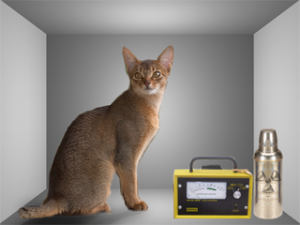Dead cats can live again if they are quantum cats
Posted 3rd November 2014The Austrian father of quantum mechanics, Erwin Schrödinger, famously imagined sealing a cat inside a box. The cat’s fate would be linked to the quantum world through a poison that will be released only if a single radioactive atom decays.

Schrödinger pointed out that the equations of quantum mechanics insist that the atom must exist in a peculiar state called ‘superposition’ until it is observed, a state in which it has both decayed and not decayed and is described by a mathematical formula now known as Schrödinger’s wave function. But if the cat’s survival depends on what the atom does, then it must also exist as a superposition of a live and a dead cat until Professor Schrödinger opens the box and observes it. At that point, the cat’s fate become entangled with that of the Professor whose observation is considered to have measured the wave function causing it to ‘collapses’ into one of the two possible states: the cat will be found dead or alive and in this case we’ll imagine the unfortunate feline is found to have sadly deceased.
Physicists generally assume the measurement process to be irreversible because, once the box is opened, information about cat’s fate finds its way out of the box into the Professor’s brain and that of his colleagues, friends, family and all the trillions of particles of which they are composed. Once the cat’s fate has been let out of the metaphorical bag it can never be returned to its superposition state.
But what happens if the cat’s fate is kept a secret known only to a few particles? In this case it’s possible to wipe out the information about the cat’s fate before it disseminates. Will the dead cat revive?
This is what a group of scientists based at the Weizmann Institute of Science in Israel have recently achieved (Weisz, Science 2014). The researchers use a pair of electronic devices called Mach-Zehnder interferometers (MZIs) as both cat and measuring device. The cat is an electron within one of the MZI’s which is placed in a superposition of two states, we’ll call them dead and alive. This then interacts with an electron in the second MZI, we’ll call it to the Professor. This interaction forces the cat electron’s wave function to collapse into one of its two possible states and its choice is recorded in the state of the Professor electron. Let’s say the cat electron is found to be in the dead state.
But in this simple system the scientists can erase the information about the cat electron’s state from the Professor electron. When this happens, the original electronic superposition of live and dead electron cat is restored. Now if the experiment is repeated the next outcome of the wave function collapse may be that cat electron will collapse into the live rather than the dead state. The dead electron cat will magically be brought back to life!
Of course electrons are not real cats and performing an analogous experiment with systems as big as the domestic moggy is much more difficult because its extraordinarily hard to catch and erase all the escaping information. In principle it could be done but in practice it would be impossible.
But what about living systems? As Jim Al-Khalili and I argue in our new book, Life on the Edge, life lives on the edge of the classical and quantum worlds. Could quantum information be erased within living cells to help maintain their delicate quantum states?
